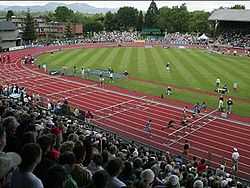Oregon Track Club
| Oregon Track Club | |
|---|---|
 Hayward Field is the heart of Oregon Track and Field | |
| Abbreviation | OTC |
| Formation | 1958 as Emerald Empire Athletic Association |
| Location | Eugene, Oregon |
| Website | http://www.runnerspace.com/oregontrackclub |
The Oregon Track Club (OTC) is an American running organization based in Eugene, Oregon.
History
The OTC has gone through several distinct changes since forming over 50 years ago.
Emerald Empire Athletic Association
Formed by Bill Bowerman, the Emerald Empire Athletic Association (EEAA) was the predecessor to the Oregon Track Club. In 1948, Bill Bowerman became the head track coach at the University of Oregon, in Eugene, Oregon. In order to spur interest in running with the local community, Bowerman formed an all comers meet for grade schoolers in 1949. The next year the meet was expanded to include high school and college athletes. The success of the all comers meet caused Bowerman to want to increase his efforts in promoting track and field in Eugene. In 1958, with the help of Ray Hendrickson and Bob Newland, Bowerman established the Emerald Empire Athletic Association. Ralph Christensen became the first president of the EEAA, and along with the other leaders established the goals for the EEAA:[1]
- To promote youth program for youngsters in track and field.
- To provide training assistance and facilities for track and field athletes of all ages.
- To sponsor one big track meet each summer as a fundraising event to support the other goals.
Change to Oregon Track Club
In 1965 the Emerald Empire Athletic Association changed its name to the Oregon Track Club. This was in part due to the leadership's desire to concentrate mainly on track and field.[1] Beginning in the late 1960s, the OTC started to become a dominant force in American Track and Field. Due to the relationship between the University of Oregon and the Oregon Track Club (both in Eugene, same coaches), many athletes from the University of Oregon's strong cross country and track and field programs decided to remain in Eugene to compete with the Oregon Track Club. The most notable of these athletes are Steve Prefontaine, who while running with the OTC placed fourth in the 1972 Summer Olympics in the men's 5000 meters race,[2] and Mac Wilkins, who received the gold medal in the discus throw at the 1976 Summer Olympics. During this period of dominance, the OTC sent dozens of athletes to the Olympics, won several medals, and would have even more success had it not been for the 1980 Summer Olympics boycott that the American athletes participated in.
Branches of the Oregon Track Club
The Oregon Track Club is made up of three branches: the general club, the elite club, and the masters club.
General Club

Elite
OTC Elite is the professional branch of the OTC and is based in Eugene, Oregon. The current format of the club was created in 2006 and originally coached by Frank Gagliano. In 2008 Mark Rowland became the Head Coach of OTC. For a time there were three groups of athletes who wore the OTC Elite uniform, one coached by Alberto Salazar and one coached by Jerry Schumacher. The team has had great success in recent years, culminating at the 2011 IAAF World Championships with High Jumper Jesse Williams winning Gold, Ashton Eaton winning Silver in the Decathlon and Sally Kipyego winning Silver in the 10,000 meters.[3]
Masters
The masters and submasters division of the OTC is a subgroup of the OTC designed for older members to stay competitive. The masters and submasters divisions have age restrictions to provide fair competition between athletes: 40 years old and older for the masters division and 30 to 39 years old for the submasters division. The OTC's masters division hosts the Hayward Classic, which is one of the premier masters track meets in the country.[4]
Runners
Notable current athletes
The following athletes compete as part of the OTC Elite in Eugene:[5]
- Russell Wolf Brown
- Sam Chelanga
- Ashton Eaton
- Cyrus Hostetler
- Sally Kipyego
- Tyler Mulder
- Lachlan Renshaw
- Andrew Wheating
- Jesse Williams
- Ciaran O'Lionaird
Notable former athletes
The following athletes formerly competed in the past for the Oregon Track Club:[6]
- Margaret Bailes
- Wade Bell
- Dyrol Burleson
- Bill Dellinger
- Steve Prefontaine
- Nick Symmonds
- Mac Wilkins
- Alan Webb
Coaches
The following have coached for OTC.
- Mark Rowland - current OTC Elite Head Coach
- Bill Bowerman
- Bill Dellinger
- Frank Gagliano
- Bob Newland
- Alberto Salazar (Nike Oregon Project)
- Jerry Schumacher (Nike Oregon Project)
Nike relationship
The OTC has had a long-standing close relationship with Nike, Inc. over the years. This relationship is due mostly to the fact that one of Nike's founders was OTC founder Bill Bowerman. It is also because Nike's main founder Phil Knight was a middle distance runner for the University of Oregon[7] and had a close relationship with many of the athletes in the OTC. Throughout the years, Nike has contributed strongly to the OTC by supplying equipment and sponsoring competitions for athletes to compete against other track clubs across the nation. This relationship has greatly increased with the re-establishment of the OTC Elite.
References
- ↑ 1.0 1.1 "Oregon Track Club History", retrieved 23 November 2010
- ↑ GoPre.com retrieved 23 November 2010
- ↑ retrieved 1 March 2012
- ↑ "OTC Masters" retrieved 6 December 2010
- ↑ "OTC Elite Roster, retrieved 1 March 2012
- ↑ "Olympics at Sports-Reference", retrieved 6 December 2010
- ↑ Krentzman, Jackie. [http://www.stanfordalumni.org/news/magazine/1997/janfeb/articles/knight.html, "The Force Behind the Nike Empire"], Stanford Magazine, retrieved 7 December 2010